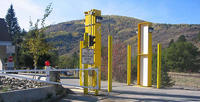-
Local resistance to bomb sniffing-dogs training facility
As fear of domestic terrorism grows, so does the need for explosive-sniffing dogs; company with DHS detection credentials wants to convert a horse barn in New York into a commercial kennel for bomb-sniffing dogs, but the neighbors object
-
-
New way to sniff out shoe bombs
Triacetone triperoxide (TATP) is a high-powered explosive that in recent years has been used in several bombing attempts. TATP is easy to prepare from readily available components and has been difficult to detect. It defies most standard methods of chemical sensing: It does not fluoresce, absorb ultraviolet light, or readily ionize; University of Illinois researchers offers a solution that overcomes these problems
-
-
End to limits on carrying liquids on board in sight
New bottled liquid scanners unveiled; researchers at the Los Alamos National Laboratory developed a magnetic resonance device to read liquids’ molecular makeup, even when the substances are in metal containers; the device is so sensitive it can tell the difference between red and white wine, and between different types of soda; satisfactory test result may spell the end of limitations on carrying liquids on board
-
-
New nuclear detection method does not use helium
Current nuclear detection technology uses helium 3, which was a by-product of the U.S. earlier nuclear weapons programs and which is in increasingly short supply; Dynasil’s new “dual mode” detectors are designed to work without helium 3 and can replace two separate nuclear detector systems for gamma radiation and for the neutrons from nuclear materials
-
-
Italian airport security drop body scanners
After a six-month test, Italy is giving up full-body scanners for security checks in airports; officials said it takes longer to check a person by scanner — about thirty seconds — than by hand, and privacy measures reduced the scanners’ effectiveness
-
-
New detector tests for illegal drugs, superbugs in minutes
A new method of detecting illegal drugs and super bugs will be used in a U.K. government-backed handheld device that analyzes saliva; the testing takes minutes and costs as little as £1.50 per test; it works by measuring the electric charge generated when the substances in the saliva react with an electrode coated with antibodies
-
-
New TNT detector 1,000 more sensitive than sniffer dogs
Israeli researchers develop an explosives detector that can detect extremely small traces of commonly used explosives in liquid or air in a few seconds; the device is a thousand times more sensitive than the current gold standard in explosives detection: the sniffer dog
-
-
DHS gives New York $18 million for radiation detection system
DHS will hand New York $18.5 million today to keep the city’s prototype dirty-bomb detection system running; the nuclear detection operation is run out of an operations center in the city, featuring more than 4,500 pieces of radiation detection equipment, many equipped with GPS locators
-
-
DHS announces $98 million for advanced X-ray technologies
Next-generation advanced technology (AT) X-ray systems screen carry-on baggage for explosives or prohibited items at checkpoints; currently, TSA employs more than 940 AT X-ray units at airports nationwide; $98 million will fund the deployment of additional units
-
-
GAO: $4 billion border radiation detectors program a bust

The Government Accountability Office (GAO) reported Wednesday that the $4 billion program to install radiation detectors at U.S. border crossings yielded few tangible results; the detection machines were too big for border inspection lanes, and the software for the Cargo Advanced Automated Radiography Systems also was not up to the task; DHS: “We are mindful of getting something delivered that has a credible basis for the implementation plan that follows”
-
-
Insect-size air vehicles to explore, monitor hazardous environments
High-performance micro air vehicles (MAVs) are on track to evolve into robotic, insect-scale devices for monitoring and exploration of hazardous environments, such as collapsed structures, caves and chemical spills
-
-
1st Detect in $735,000 contract for chemical detection in the field
Phase II SBIR contract from the Joint Science & Technology Office for Chemical and Biological Defense will allow the company to design and develop a novel sample inlet system intended to improve the sensitivity of mass spectrometers used for chemical detection in the field
-
-
University lab tech's suicide by cyanide prompts safety fears
A Northeastern University lab technician stole cyanide from the lab, which she then used to kill herself; suicide raises public safety fears over easy access to deadly chemicals; one terrorism expert, though, says that many incidents of dangerous chemicals stolen from college labs are used by the thief against themselves and not others; “It’s the jilted lover, the disgruntled employee, it’s the suicide not the suicide attack”
-
-
New upgrades will make full-body scanners less privacy-offensive
New software upgrade to full-body scanners would replace the images of a passenger’s naked body with an avatar and alert authorities to a potential hidden threat, eliminating the need to keep an employee in a remote room
-
-
Sandia Labs developed an IED-disabling water-blade device
A device developed by Sandia National Laboratories researchers that shoots a blade of water capable of penetrating steel is headed to U.S. troops in Afghanistan to help them disable deadly IEDs; the portable clear plastic device is filled with water and an explosive material is placed in it that, when detonated, creates a shock wave that travels through the water and accelerates it inward into a concave opening; when the water collides, it produces a thin blade
-
More headlines
The long view
Keeping the Lights on with Nuclear Waste: Radiochemistry Transforms Nuclear Waste into Strategic Materials
How UNLV radiochemistry is pioneering the future of energy in the Southwest by salvaging strategic materials from nuclear dumps –and making it safe.
Model Predicts Long-Term Effects of Nuclear Waste on Underground Disposal Systems
The simulations matched results from an underground lab experiment in Switzerland, suggesting modeling could be used to validate the safety of nuclear disposal sites.
